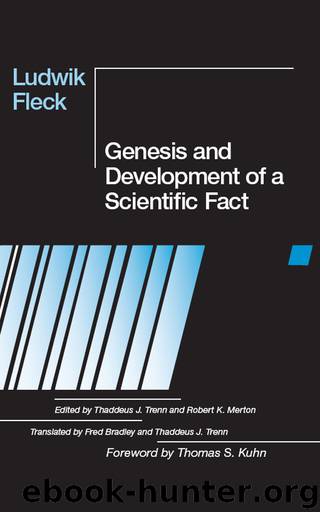Genesis and Development of a Scientific Fact by Fleck Ludwik

Author:Fleck, Ludwik [Fleck, Ludwik]
Language: eng
Format: epub
Publisher: University of Chicago Press
Published: 2012-09-04T16:00:00+00:00
Then the procedure would be repeated for transparency and for all other properties. If one were to compare the data in the two tables with each other and to place the relevant colonies beside one another, tabulated according to their ranking, one would find that very light color, together with other conspicuous properties, occurs only in the two very small colonies. Furthermore, the differences between these two colonies and all the others far exceed the fluctuations among the properties of the others when they are compared with one another. They would therefore constitute a distinct type of colony, which was the point to be demonstrated and which would thus have been demonstrated without any assumptions having been made.
This description contains some gross errors, which are committed by many theoreticians. First , assumptions are already incorporated within the choice and limitation of the object of investigation. With 102 undoubted colonies, there are certain to be a few doubtful features such as grains or dots that might be regarded as colonies or even as accidental structures, depending upon the assumptions.
Second , it is altogether pointless to speak of all the characteristic of a structure. The number of characteristics can be as large as desired, and the number of possible determinations of characteristics depends upon the habits of thought of the given scientific discipline; that is, it already contains directional assumptions. Accordingly such mechanical combinatorial analyses are either arbitrary or actually conditioned by thought style.
Third , new discoveries cannot be carried out by such tabulations and mechnically exhaustive combinations any more than, for instance, a poem can be composed by means of combining letters mechanically.
Observation without assumption, 3 which psychologically is nonsense and logically a game, can therefore be dismissed. But two types of observation, with variations along a transitional scale, appear definitely worth investigating: (1) the vague initial visual perception , and (2) the developed direct visual perception of a form .
Direct perception of form [ Gestaltsehen ] requires being experienced in the relevant field of thought. The ability directly to perceive meaning, form, and self-contained unity is acquired only after much experience, perhaps with preliminary training. At the same time, of course, we lose the ability to see something that contradicts the form. But it is just this readiness for directed perception that is the main constituent of thought style. Visual perception of form therefore becomes a definite function of thought style. The concept of being experienced, with its hidden irrationality, acquires fundamental epistemological importance, which will presently be discussed in detail.
By contrast, the vague, initial visual perception is unstyled. Confused partial themes in various styles are chaotically thrown together. Contradictory moods have a random influence upon undirected vision. There is a rivalry among visual fields of thought. Nothing is factual or fixed. Things can be seen almost arbitrarily in this light or that. There is neither support, nor constraint, nor resistance and there is no “firm ground of facts.”
All empirical discovery can therefore be construed as a supplement, development, or transformation of the thought style .
Download
This site does not store any files on its server. We only index and link to content provided by other sites. Please contact the content providers to delete copyright contents if any and email us, we'll remove relevant links or contents immediately.
Enlightenment Now: The Case for Reason, Science, Humanism, and Progress by Steven Pinker(6847)
A Journey Through Charms and Defence Against the Dark Arts (Harry Potter: A Journey Through…) by Pottermore Publishing(4710)
A Journey Through Divination and Astronomy by Publishing Pottermore(4235)
The Immortal Life of Henrietta Lacks by Rebecca Skloot(4226)
Elon Musk by Ashlee Vance(3827)
Origin Story: A Big History of Everything by David Christian(3451)
COSMOS by Carl Sagan(3317)
Alchemy and Alchemists by C. J. S. Thompson(3270)
Enlightenment Now by Steven Pinker(3254)
Shadow of Night by Deborah Harkness(3156)
Inferior by Angela Saini(3131)
A Mind For Numbers: How to Excel at Math and Science (Even If You Flunked Algebra) by Barbara Oakley(3082)
Bad Pharma by Ben Goldacre(3068)
Origin Story by David Christian(2966)
Signature in the Cell: DNA and the Evidence for Intelligent Design by Stephen C. Meyer(2855)
The Code Book by Simon Singh(2827)
The Elements by Theodore Gray(2818)
A Brief History of Time by Stephen Hawking(2799)
A Journey Through Potions and Herbology (A Journey Through…) by Pottermore Publishing(2759)
